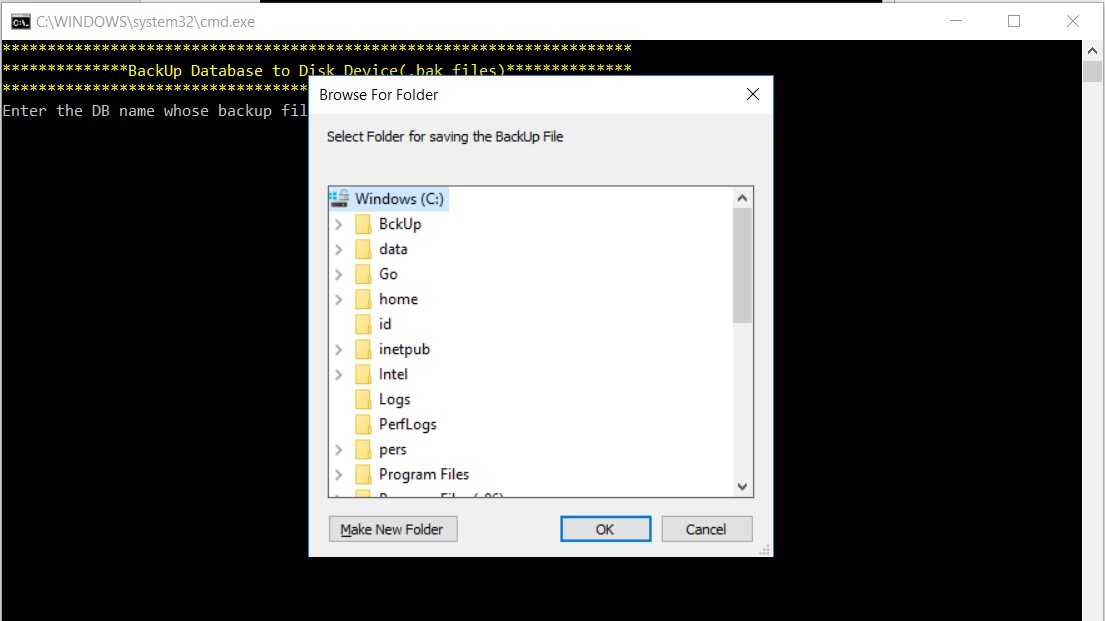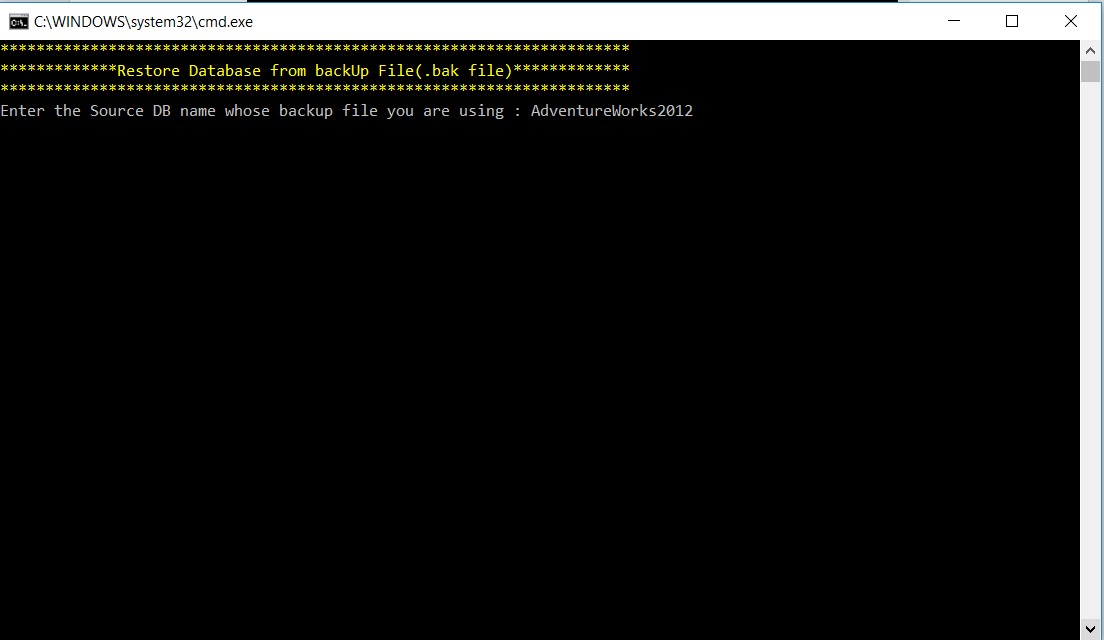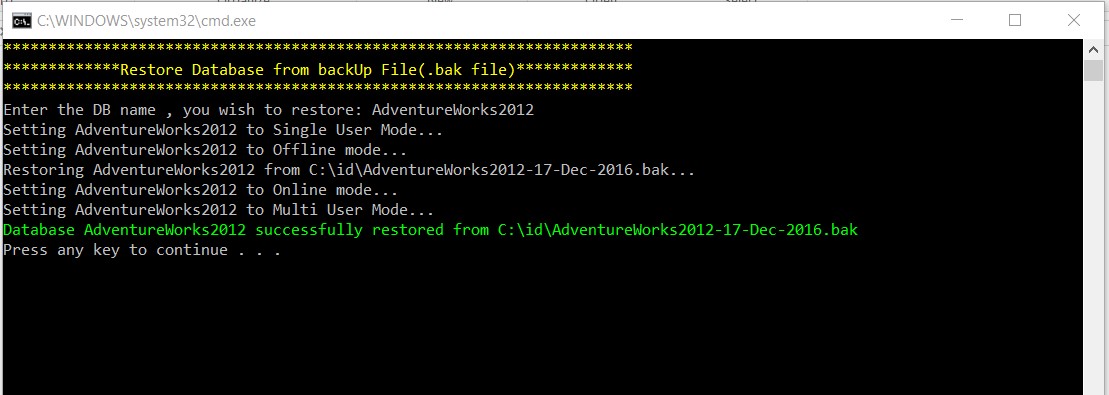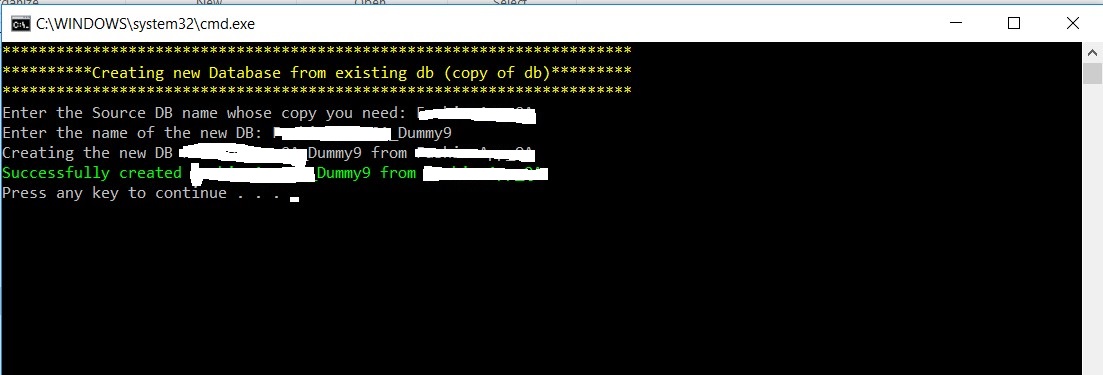Powershell Script for regular DBA activities
Most of the time, the developers come to the DBA for some routine tasks like Sql Backups and restore for different development and testing environments. This requires DBA to manually perform these operations via SSMS. Sometimes the operation is straight forward, while most of the times we have to configure some advanced options for our operations.
This small powershell utility takes care of such operations and elegantly performs it via command shell without SSMS interaction.
Such utilities can be easily used by the developers in the team without making them approach to DBA for such tasks on various development or testing environments.
Please note, this tool supports below operations on the same Sql Server machine :
1. Backup a DB to a physical .bak file
2. Restore a DB from a .bak file
3. Restore a DB from a DB
4. Create a new DB from existing DB
Below is the working of this utility explained:

(1)Creating a backup file for a database (Enter Option 1)

Enter the database name, whose backup you need, then it will give you a browse folder window to select the folder where the file should be saved

Select the folder and it’s done.

(2)Restore Database from .bak file (saved on disk) (Enter Option 2)

Enter the name of the DB, whose backup file you are using.

Enter the name of the Database, that you wish to restore. After which it gives you file dialog box to select the .bak file for restoring

And its done.
(3)Restore database from database (Enter Option 3)
Just enter the source and the destination database

(4)Create a new database from existing database (Enter Option 4)
Enter the name of the source database and the new database

[System.Reflection.Assembly]::LoadWithPartialName("System.windows.forms") | Out-Null
#Below variables should be modified as per the Machine settings#
###########################################################################################################
$SqlConnectionString = "Server = <servername>; Database = master; User ID= <username>; Password= <password>"
###########################################################################################################
$SqlCommand = New-Object System.Data.SqlClient.SqlCommand
$SqlCommand.CommandTimeout = 0
$SqlConnection = New-Object System.Data.SqlClient.SqlConnection
$SqlConnection.ConnectionString = $SqlConnectionString
$app = new-object -com Shell.Application
$fd = New-Object system.windows.forms.openfiledialog
$fd.InitialDirectory = 'c:'
$fd.MultiSelect = $false
$CurrentDate = Get-Date -format "dd-MMM-yyyy"
function SetSingleUserMode($DbName){
write-host "Setting $DBName to Single User Mode..."
$SqlCommand.CommandText = "ALTER DATABASE $DbName SET SINGLE_USER WITH ROLLBACK IMMEDIATE;"
try{
$SqlCommand.ExecuteNonQuery() | Out-Null
}
catch{
write-host $_.Exception.Message -foregroundcolor "red"
$SqlConnection.Close()
break
}
}
function SetMultipleUserMode($DbName){
write-host "Setting $DBName to Multi User Mode..."
$SqlCommand.CommandText = "ALTER DATABASE $DbName SET MULTI_USER;"
try{
$SqlCommand.ExecuteNonQuery() | Out-Null
}
catch{
write-host $_.Exception.Message -foregroundcolor "red"
$SqlConnection.Close()
break
}
}
function SetToOfflineMode($DbName){
write-host "Setting $DBName to Offline mode..."
$SqlCommand.CommandText = "ALTER DATABASE $DbName SET OFFLINE WITH ROLLBACK IMMEDIATE;"
try{
$SqlCommand.ExecuteNonQuery() | Out-Null
}
catch{
write-host $_.Exception.Message -foregroundcolor "red"
$SqlConnection.Close()
break
}
}
function SetToOnlineMode($DbName){
write-host "Setting $DBName to Online mode..."
$SqlCommand.CommandText = "ALTER DATABASE $DbName SET ONLINE;"
try{
$SqlCommand.ExecuteNonQuery() | Out-Null
}
catch{
write-host $_.Exception.Message -foregroundcolor "red"
$SqlConnection.Close()
break
}
}
function checkIfDbExists($DbName)
{
$SqlCommand.CommandText = "select 1 from sys.databases where name = '$DbName';"
$reader = $SqlCommand.ExecuteReader()
try{
if($reader.HasRows)
{
$reader.Close()
}
else{
write-host "Database : $DbName doesn't exist, Script will exit now" -foregroundcolor "red"
$reader.Close()
$SqlConnection.Close()
break
}
}
catch{
write-host $_.Exception.Message -foregroundcolor "red"
$SqlConnection.Close()
break
}
}
function RestoreDBFromFile{
$SourceDBName = Read-Host "Enter the Source DB name whose backup file you are using "
$DbName = read-host "Enter the Destination DB name , you wish to restore"
try{
$SqlConnection.Open()
}
catch{
write-host $_.Exception.Message -foregroundcolor "red"
$SqlConnection.Close()
break
}
$SqlCommand.Connection = $SqlConnection
checkIfDbExists($DbName)
checkIfDbExists($SourceDBName)
$result = $fd.ShowDialog()
if($result -ne "OK"){
write-host "You didn't select a valid file"
break
}
else{
$bckFileName = $fd.FileName
}
SetSingleUserMode($DbName)
SetToOfflineMode($DbName)
write-host "Restoring $DBName from $bckFileName..."
#$SqlCommand.CommandText = "RESTORE DATABASE $DbName FROM DISK = '$bckFileName';"
$SqlCommand.CommandText = "
declare @SrcDataName varchar(200)
,@SrcLogName varchar(200)
,@DestDataPhyLoc varchar(max)
,@DestLogPhyLoc varchar(max)
,@SourceDBName varchar(200)
,@DestDBName varchar(200)
,@DestDataName varchar(200)
,@DestLogName varchar(200)
,@BckUpPath varchar(max)
,@v_error_msg NVARCHAR(2048) = NULL
set @SourceDBName= '$SourceDBName'
set @DestDBName = '$DbName'
set @BckUpPath= '$bckFileName'
select @SrcDataName = mf.name from sys.master_files mf
join sys.databases db on mf.database_id = db.database_id
where db.name = @SourceDBName
and type_desc = 'ROWS'
select @SrcLogName = mf.name from sys.master_files mf
join sys.databases db on mf.database_id = db.database_id
where db.name = @SourceDBName
and type_desc = 'Log'
select @DestDataPhyLoc = mf.physical_name from sys.master_files mf
join sys.databases db on mf.database_id = db.database_id
where db.name = @DestDBName
and type_desc = 'ROWS'
select @DestLogPhyLoc = mf.physical_name from sys.master_files mf
join sys.databases db on mf.database_id = db.database_id
where db.name = @DestDBName
and type_desc = 'LOG'
print @SrcDataName
Print @SrcLogName
print @DestDataPhyLoc
Print @DestLogPhyLoc
print ('ALTER DATABASE ' + @DestDBName + ' SET SINGLE_USER WITH ROLLBACK IMMEDIATE;')
EXEC ('ALTER DATABASE ' + @DestDBName + ' SET SINGLE_USER WITH ROLLBACK IMMEDIATE;')
BEGIN TRY
print ('
RESTORE DATABASE ' + @DestDBName + ' FROM DISK = ''' + @BckUpPath + '''
WITH REPLACE,
MOVE ''' + @SrcDataName + ''' TO ''' + @DestDataPhyLoc + ''', MOVE ''' + @SrcLogName + ''' TO ''' + @DestLogPhyLoc + ''''
)
Exec ('
RESTORE DATABASE ' + @DestDBName + ' FROM DISK = ''' + @BckUpPath + '''
WITH REPLACE,
MOVE ''' + @SrcDataName + ''' TO ''' + @DestDataPhyLoc + ''', MOVE ''' + @SrcLogName + ''' TO ''' + @DestLogPhyLoc + ''''
)
select @DestDataName = mf.name from sys.master_files mf
join sys.databases db on mf.database_id = db.database_id
where db.name = @DestDBName
and type_desc = 'ROWS'
select @DestLogName = mf.name from sys.master_files mf
join sys.databases db on mf.database_id = db.database_id
where db.name = @DestDBName
and type_desc = 'Log'
IF(@DestDataName <> @DestDBName + '_Data')
BEGIN
print ('ALTER DATABASE ' + @DestDBName + ' MODIFY FILE(NAME = N''' + @DestDataName + ''', NEWNAME = N''' + @DestDBName + '_Data'')')
EXEC ('ALTER DATABASE ' + @DestDBName + ' MODIFY FILE(NAME = N''' + @DestDataName + ''', NEWNAME = N''' + @DestDBName + '_Data'')')
END
IF(@DestLogName <> @DestDBName + '_Log')
BEGIN
print ('ALTER DATABASE ' + @DestDBName + ' MODIFY FILE(NAME = N''' + @DestLogName + ''', NEWNAME = N''' + @DestDBName + '_Log'')')
EXEC ('ALTER DATABASE ' + @DestDBName + ' MODIFY FILE(NAME = N''' + @DestLogName + ''', NEWNAME = N''' + @DestDBName + '_Log'')')
END
print ('ALTER DATABASE ' + @DestDBName + ' SET MULTI_USER;')
Exec ('ALTER DATABASE ' + @DestDBName + ' SET MULTI_USER;')
END TRY
BEGIN CATCH
print ('ALTER DATABASE ' + @DestDBName + ' SET MULTI_USER;')
Exec ('ALTER DATABASE ' + @DestDBName + ' SET MULTI_USER;')
SET @v_error_msg = FORMATMESSAGE('%d|%d|%s', ERROR_NUMBER(), ERROR_LINE(), ERROR_MESSAGE());
THROW 51000, @v_error_msg, 1
END CATCH
"
try{
$SqlCommand.ExecuteNonQuery() | Out-Null
}
catch{
write-host $_.Exception.Message -foregroundcolor "red"
SetToOnlineMode($DbName)
SetMultipleUserMode($DbName)
break
}
SetToOnlineMode($DbName)
SetMultipleUserMode($DbName)
try{
$SqlConnection.Close()
}
catch{
write-host $_.Exception.Message -foregroundcolor "red"
break
}
Write-Host "Database $DbName successfully restored from $bckFileName" -ForegroundColor Green
}
function BackUpDB{
$DbName = read-host "Enter the DB name whose backup file (.bak) you wish to save"
try{
$SqlConnection.Open()
}
catch{
write-host $_.Exception.Message -foregroundcolor "red"
$SqlConnection.Close()
break
}
$SqlCommand.Connection = $SqlConnection
checkIfDbExists($DbName)
$folder = $app.BrowseForFolder(0, "Select Folder for saving the BackUp File", 0, "C:\")
if ($folder.Self.Path -eq "") {
# write-host "You selected " $folder.Self.Path
write-host "You didn't select a valid folder, the script will exit"
break
}
if ($folder.Self.Path -eq $null) {
# write-host "You selected " $folder.Self.Path
write-host "You didn't select a valid folder, the script will exit"
break
}
$filelocation = $folder.Self.Path
SetSingleUserMode($DbName)
write-host "Creating the backup file for $DbName ..."
$SqlCommand.CommandText = "BACKUP DATABASE $DbName TO DISK = '$filelocation\$DbName-$CurrentDate.bak' WITH FORMAT,NAME = '$DbName';"
try{
$SqlCommand.ExecuteNonQuery() | Out-Null
}
catch{
write-host $_.Exception.Message -foregroundcolor "red"
$SqlConnection.Close()
break
}
SetMultipleUserMode($DbName)
write-host "Database $DbName is backed up at $filelocation\$DbName-$CurrentDate.bak" -ForegroundColor Green
try{
$SqlConnection.Close()
}
catch{
write-host $_.Exception.Message -foregroundcolor "red"
break
}
}
function RestoreFromDB{
$SourceDbName = read-host "Enter the Source DB name whose backup you need"
$DestDbName = read-host "Enter the Destination DB name , you wish to restore to"
try{
$SqlConnection.Open()
}
catch{
write-host $_.Exception.Message -foregroundcolor "red"
$SqlConnection.Close()
break
}
$SqlCommand.Connection = $SqlConnection
checkIfDbExists($SourceDbName)
checkIfDbExists($DestDbName)
SetSingleUserMode($SourceDbName)
#write-host "Creating the backup file for $SourceDbName ..."
$SqlCommand.CommandText = "BACKUP DATABASE $SourceDbName TO DISK = 'C:\$SourceDbName-$CurrentDate.bak' WITH FORMAT,NAME = '$SourceDbName';"
try{
$SqlCommand.ExecuteNonQuery() | Out-Null
}
catch{
write-host $_.Exception.Message -foregroundcolor "red"
$SqlConnection.Close()
break
}
SetMultipleUserMode($SourceDbName)
#write-host "Database $SourceDbName is backed up at $filelocation\$SourceDbName-$CurrentDate.bak"
SetSingleUserMode($DestDbName)
SetToOfflineMode($DestDbName)
#$SqlCommand.CommandText = "RESTORE DATABASE $DestDbName FROM DISK = 'C:\$SourceDbName-$CurrentDate.bak';"
$SqlCommand.CommandText = "
declare @SrcDataName varchar(200)
,@SrcLogName varchar(200)
,@DestDataPhyLoc varchar(max)
,@DestLogPhyLoc varchar(max)
,@SourceDBName varchar(200)
,@DestDBName varchar(200)
,@DestDataName varchar(200)
,@DestLogName varchar(200)
,@BckUpPath varchar(max)
,@v_error_msg NVARCHAR(2048) = NULL
set @SourceDBName= '$SourceDbName'
set @DestDBName = '$DestDbName'
set @BckUpPath= 'C:\$SourceDbName-$CurrentDate.bak'
select @SrcDataName = mf.name from sys.master_files mf
join sys.databases db on mf.database_id = db.database_id
where db.name = @SourceDBName
and type_desc = 'ROWS'
select @SrcLogName = mf.name from sys.master_files mf
join sys.databases db on mf.database_id = db.database_id
where db.name = @SourceDBName
and type_desc = 'Log'
select @DestDataPhyLoc = mf.physical_name from sys.master_files mf
join sys.databases db on mf.database_id = db.database_id
where db.name = @DestDBName
and type_desc = 'ROWS'
select @DestLogPhyLoc = mf.physical_name from sys.master_files mf
join sys.databases db on mf.database_id = db.database_id
where db.name = @DestDBName
and type_desc = 'LOG'
print @SrcDataName
Print @SrcLogName
print @DestDataPhyLoc
Print @DestLogPhyLoc
print ('ALTER DATABASE ' + @DestDBName + ' SET SINGLE_USER WITH ROLLBACK IMMEDIATE;')
EXEC ('ALTER DATABASE ' + @DestDBName + ' SET SINGLE_USER WITH ROLLBACK IMMEDIATE;')
BEGIN TRY
print ('
RESTORE DATABASE ' + @DestDBName + ' FROM DISK = ''' + @BckUpPath + '''
WITH REPLACE,
MOVE ''' + @SrcDataName + ''' TO ''' + @DestDataPhyLoc + ''', MOVE ''' + @SrcLogName + ''' TO ''' + @DestLogPhyLoc + ''''
)
Exec ('
RESTORE DATABASE ' + @DestDBName + ' FROM DISK = ''' + @BckUpPath + '''
WITH REPLACE,
MOVE ''' + @SrcDataName + ''' TO ''' + @DestDataPhyLoc + ''', MOVE ''' + @SrcLogName + ''' TO ''' + @DestLogPhyLoc + ''''
)
select @DestDataName = mf.name from sys.master_files mf
join sys.databases db on mf.database_id = db.database_id
where db.name = @DestDBName
and type_desc = 'ROWS'
select @DestLogName = mf.name from sys.master_files mf
join sys.databases db on mf.database_id = db.database_id
where db.name = @DestDBName
and type_desc = 'Log'
IF(@DestDataName <> @DestDBName + '_Data')
BEGIN
print ('ALTER DATABASE ' + @DestDBName + ' MODIFY FILE(NAME = N''' + @DestDataName + ''', NEWNAME = N''' + @DestDBName + '_Data'')')
EXEC ('ALTER DATABASE ' + @DestDBName + ' MODIFY FILE(NAME = N''' + @DestDataName + ''', NEWNAME = N''' + @DestDBName + '_Data'')')
END
IF(@DestLogName <> @DestDBName + '_Log')
BEGIN
print ('ALTER DATABASE ' + @DestDBName + ' MODIFY FILE(NAME = N''' + @DestLogName + ''', NEWNAME = N''' + @DestDBName + '_Log'')')
EXEC ('ALTER DATABASE ' + @DestDBName + ' MODIFY FILE(NAME = N''' + @DestLogName + ''', NEWNAME = N''' + @DestDBName + '_Log'')')
END
print ('ALTER DATABASE ' + @DestDBName + ' SET MULTI_USER;')
Exec ('ALTER DATABASE ' + @DestDBName + ' SET MULTI_USER;')
END TRY
BEGIN CATCH
print ('ALTER DATABASE ' + @DestDBName + ' SET MULTI_USER;')
Exec ('ALTER DATABASE ' + @DestDBName + ' SET MULTI_USER;')
SET @v_error_msg = FORMATMESSAGE('%d|%d|%s', ERROR_NUMBER(), ERROR_LINE(), ERROR_MESSAGE());
THROW 51000, @v_error_msg, 1
END CATCH
"
try{
$SqlCommand.ExecuteNonQuery() | Out-Null
}
catch{
write-host $_.Exception.Message -foregroundcolor "red"
SetToOnlineMode($DestDbName)
SetMultipleUserMode($DestDbName)
break
}
SetToOnlineMode($DestDbName)
SetMultipleUserMode($DestDbName)
try{
$SqlConnection.Close()
}
catch{
write-host $_.Exception.Message -foregroundcolor "red"
break
}
write-host "$DestDbName is restored from $SourceDbName" -ForegroundColor Green
}
function createDbFromExistingDB(){
$SourceDbName = read-host "Enter the Source DB name whose copy you need"
$DestDbName = read-host "Enter the name of the new DB"
if($DestDbName -eq ""){
write-host "You didn't enter a valid name for new db, program will exit now" -ForegroundColor "red"
break
}
try{
$SqlConnection.Open()
}
catch{
write-host $_.Exception.Message -foregroundcolor "red"
$SqlConnection.Close()
break
}
$SqlCommand.Connection = $SqlConnection
checkIfDbExists($SourceDbName)
$SqlScript = "
DECLARE@DBToBeBackedUp VARCHAR(200)
, @NewDBName VARCHAR(200)
, @LogicalDBName VARCHAR(100)
, @LogicalDBLogName VARCHAR(100)
, @LogicalDBNameloc VARCHAR(200)
, @LogicalDBLogNameloc VARCHAR(200);
SET @DBToBeBackedUp = '$SourceDbName';
SET @NewDBName = '$DestDbName';
IF NOT EXISTS
(
SELECT 1
FROM [sys].[databases]
WHERE [name] = @DBToBeBackedUp
)
BEGIN
PRINT('DB to be backed up i.e. '+@DBToBeBackedUp+' doesn''t exist');
END;
ELSE
BEGIN
BEGIN
IF EXISTS
(
SELECT 1
FROM [sys].[databases]
WHERE [name] = @NewDBName
)
BEGIN
PRINT('The New DB i.e. '+@NewDBName+' already exists');
END;
ELSE
BEGIN
SELECT @LogicalDBName = [mf].[name],
@LogicalDBNameloc = SUBSTRING([mf].[physical_name], 0, LEN([physical_name])-LEN(REVERSE(SUBSTRING(REVERSE([mf].[physical_name]), 0, CHARINDEX('\', REVERSE([mf].[physical_name])))))+1)
FROM [sys].[databases] [db]
JOIN [sys].[master_files] [mf] ON [db].[database_id] = [mf].[database_id]
WHERE [db].[name] = @DBToBeBackedUp
AND [type_desc] = 'ROWS';
SELECT @LogicalDBLogName = [mf].[name],
@LogicalDBLogNameloc = SUBSTRING([mf].[physical_name], 0, LEN([physical_name])-LEN(REVERSE(SUBSTRING(REVERSE([mf].[physical_name]), 0, CHARINDEX('\', REVERSE([mf].[physical_name])))))+1)
FROM [sys].[databases] [db]
JOIN [sys].[master_files] [mf] ON [db].[database_id] = [mf].[database_id]
WHERE [db].[name] = @DBToBeBackedUp
AND [type_desc] = 'LOG';
PRINT('Getting the backup of ['+@DBToBeBackedUp+'] and saving to '+@LogicalDBNameloc+@NewDBName+'.bak');
EXEC ('BACKUP DATABASE ['+@DBToBeBackedUp+'] TO DISK = '''+@LogicalDBNameloc+@NewDBName+'.bak''');
PRINT(@LogicalDBNameloc+@NewDBName+'.bak generated');
PRINT('Restoring the backup to ['+@NewDBName+']');
EXEC ('
RESTORE DATABASE ['+@NewDBName+'] FROM DISK = '''+@LogicalDBNameloc+@NewDBName+'.bak''
WITH
MOVE '''+@LogicalDBName+''' TO '''+@LogicalDBNameloc+@NewDBName+'.mdf''
, MOVE '''+@LogicalDBLogName+''' TO '''+@LogicalDBLogNameloc+@NewDBName+'_log.ldf''');
PRINT('Restore finished');
PRINT('Aligning the logical names');
EXEC ('
ALTER DATABASE ['+@NewDBName+'] MODIFY FILE(NAME = N'''+@LogicalDBName+''', NEWNAME = N'''+@NewDBName+''');
');
EXEC ('
ALTER DATABASE ['+@NewDBName+'] MODIFY FILE(NAME = N'''+@LogicalDBLogName+''', NEWNAME = N'''+@NewDBName+'_log'');
');
PRINT('Logical names are updated');
END;
END;
END;
"
write-host "Creating the new DB $DestDbName from $SourceDbName"
$SqlCommand.CommandText = $SqlScript
try{
$SqlCommand.ExecuteNonQuery() | Out-Null
}
catch{
write-host $_.Exception.Message -foregroundcolor "red"
break
}
write-host "Successfully created $DestDbName from $SourceDbName" -ForegroundColor Green
}
write-host "Enter the task you wish to perform today
(1) Take Backup of DB to .bak file
(2) Restore DB from existing .bak file
(3) Restore Database to Database
(4) Create New Database from existing database
(5) Clicked by Mistake :)
" -foregroundcolor Yellow
$choice = Read-Host(
"
Enter your choice [1-5]
")
if ($choice -eq '1'){
cls
write-host "**********************************************************************" -foregroundcolor Yellow
write-host "**************BackUp Database to Disk Device(.bak files)**************" -foregroundcolor Yellow
write-host "**********************************************************************" -foregroundcolor Yellow
BackUpDB
}
ElseIf($choice -eq '2'){
cls
write-host "**********************************************************************" -foregroundcolor Yellow
write-host "*************Restore Database from backUp File(.bak file)*************" -foregroundcolor Yellow
write-host "**********************************************************************" -foregroundcolor Yellow
RestoreDBFromFile
}
ElseIf($choice -eq '3'){
cls
write-host "**********************************************************************" -foregroundcolor Yellow
write-host "********Restore existing Database from Database (In same Server)******" -foregroundcolor Yellow
write-host "**********************************************************************" -foregroundcolor Yellow
RestoreFromDB
}
ElseIf($choice -eq '4'){
cls
write-host "**********************************************************************" -foregroundcolor Yellow
write-host "**********Creating new Database from existing db (copy of db)*********" -foregroundcolor Yellow
write-host "**********************************************************************" -foregroundcolor Yellow
createDbFromExistingDB
}
ElseIf($choice -eq '5'){
cls
write-host "**********************************************************************" -foregroundcolor Yellow
write-host "*******************No issues, have a great day Bye!!******************" -foregroundcolor Yellow
write-host "**********************************************************************" -foregroundcolor Yellow
break
}
else{
write-host "You didn't enter valid input, script will exit now"
break
} 










